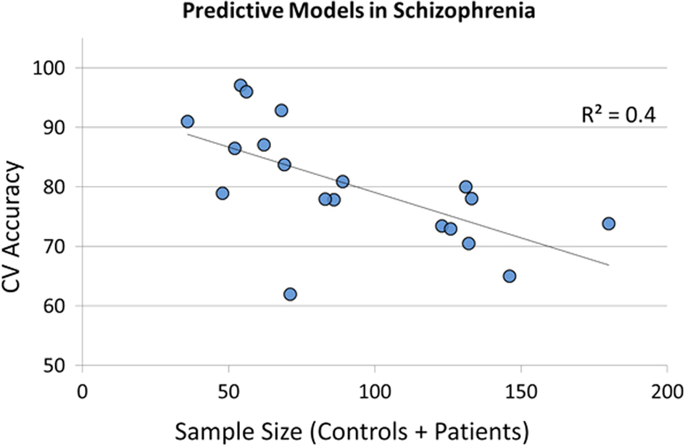npj Schizophrenia ( IF 5.7 ) Pub Date : 2019-01-18 , DOI: 10.1038/s41537-018-0070-8 Sunil Vasu Kalmady , Russell Greiner , Rimjhim Agrawal , Venkataram Shivakumar , Janardhanan C. Narayanaswamy , Matthew R. G. Brown , Andrew J Greenshaw , Serdar M Dursun , Ganesan Venkatasubramanian

|
In the literature, there are substantial machine learning attempts to classify schizophrenia based on alterations in resting-state (RS) brain patterns using functional magnetic resonance imaging (fMRI). Most earlier studies modelled patients undergoing treatment, entailing confounding with drug effects on brain activity, and making them less applicable to real-world diagnosis at the point of first medical contact. Further, most studies with classification accuracies >80% are based on small sample datasets, which may be insufficient to capture the heterogeneity of schizophrenia, limiting generalization to unseen cases. In this study, we used RS fMRI data collected from a cohort of antipsychotic drug treatment-naive patients meeting DSM IV criteria for schizophrenia (N = 81) as well as age- and sex-matched healthy controls (N = 93). We present an ensemble model -- EMPaSchiz (read as ‘Emphasis’; standing for ‘Ensemble algorithm with Multiple Parcellations for Schizophrenia prediction’) that stacks predictions from several ‘single-source’ models, each based on features of regional activity and functional connectivity, over a range of different a priori parcellation schemes. EMPaSchiz yielded a classification accuracy of 87% (vs. chance accuracy of 53%), which out-performs earlier machine learning models built for diagnosing schizophrenia using RS fMRI measures modelled on large samples (N > 100). To our knowledge, EMPaSchiz is first to be reported that has been trained and validated exclusively on data from drug-naive patients diagnosed with schizophrenia. The method relies on a single modality of MRI acquisition and can be readily scaled-up without needing to rebuild parcellation maps from incoming training images.
中文翻译:

通过多脑部拼合学习改善精神分裂症的预测,朝着心理健康领域的人工智能迈进
在文献中,有大量的机器学习尝试使用功能性磁共振成像(fMRI)基于静止状态(RS)大脑模式的变化来对精神分裂症进行分类。较早的研究对正在治疗的患者进行建模,使其与药物对脑部活动的影响混杂在一起,并使他们在首次就医时难以应用于现实世界的诊断。此外,大多数分类准确度> 80%的研究都是基于小样本数据集,这可能不足以捕获精神分裂症的异质性,从而将泛化性限于看不见的病例。在这项研究中,我们使用了从未接受过抗精神病药物治疗且符合DSM IV精神分裂症标准(N = 81)以及年龄和性别相匹配的健康对照组(N = 93)。我们提出了一个集成模型-EMPaSchiz(读作“ Emphasis”;代表“具有多个分割的集成算法用于精神分裂症的预测”),该模型堆叠了来自多个“单源”模型的预测,每个模型都基于区域活动和功能连通性的特征在一系列不同的先验分割方案中。EMPaSchiz的分类准确度为87%(相对于机会准确度为53%),其性能优于早期的机器学习模型,该模型使用基于大样本的RS fMRI测量来诊断精神分裂症(N > 100)。据我们所知,EMPaSchiz是第一个被报道的,仅针对来自确诊为精神分裂症的未经药物治疗的患者的数据进行了培训和验证。该方法依赖于MRI采集的单一方式,并且可以轻松按比例放大,而无需从传入的训练图像中重建碎片图。











































 京公网安备 11010802027423号
京公网安备 11010802027423号